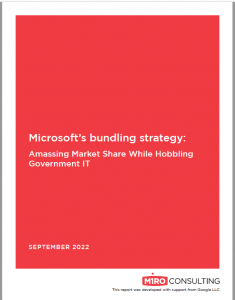 The new report addresses the question that nearly every IT professional must answer: Should my organization purchase a bundle of solutions from a single vendor or mix-and-match the “best-of-breed” services from multiple providers to meet our needs?
The new report addresses the question that nearly every IT professional must answer: Should my organization purchase a bundle of solutions from a single vendor or mix-and-match the “best-of-breed” services from multiple providers to meet our needs?
Miro examined Microsoft, one of the IT industry’s most widespread software providers, and found a best-of-breed approach is superior, particularly when it comes to cost savings and security posture. This was particularly true for public sector customers (government agencies and departments), a major purchaser of IT products and services.
Customers, regulators, and the public often do not understand the implications of Microsoft’s bundling practices. In fact, many – particularly in the U.S. public sector – are unaware that the costs for Microsoft bundled products are frequently much higher over time than opting for a best-of-breed approach with multiple providers.
In Miro’s experience, the decision to purchase a bundled IT offering is generally driven by ease-of-procurement and IT capacity considerations, rather than an organization’s actual technology needs. According to recent studies, Microsoft has 85% market share in public sector workplace collaboration and communication technology. In large part, the company has amassed this dominant market position because:
- Conditions within government procurement systems favor incumbency over security, innovation, and effectiveness.
- Microsoft takes very deliberate steps to limit competition and perpetuate its lock on the public sector market.
Limitations of Microsoft Bundling
Miro’s report found that a bundling approach has meaningful drawbacks when compared to a best-of-breed approach of mixing and matching individual software solutions and products based on the specific environment and user needs.
- Higher total costs – Microsoft bundles can be 3x the cost of best-of-breed competitors.
- Security risks – Bundled deployments remain vulnerable to attackers by creating a single attack surface and require frequent patches.
- One-size-fits-all – A single solution limits the ability to purchase offerings tailored to specific needs.
- Lack of Innovation – Government IT departments may lack the motivation or ability to switch, leading to less innovation overall.
Adopting a best-of-breed approach enables migration to cloud-built solutions, which require lower maintenance than incumbent “patch-and update” based solutions. IT support personnel currently spend up to 82% of work time maintaining incumbent solutions.
Shadow IT on the Rise
Miro’s report found that Information technology demands innovation, responsiveness, and high availability. The report also uncovered that if IT support personnel are spending most of their time outside pursuits of simply maintaining incumbent solutions, users will be less efficient at their jobs or will bring their own “shadow IT” solutions to work.
The report concludes that government agencies have the opportunity to create a system that fosters competition, security and redundancy with regard to multiple vendors. Newer and more innovative solutions may provide better services and better prices. And in the end, government agencies, users, and U.S. taxpayers will all benefit.
Download the Full Whitepaper Here
ABOUT MIRO CONSULTING
Miro is a leading global provider of software asset management services, specializing in license management, audit advisory, negotiation tactics, support management, and cloud services for Oracle, Microsoft, IBM, Salesforce and Amazon Web Services. Miro’s performance guarantee promises that our long-tenured, diverse, and passionate team of expert analysts provides insightful and actionable advice to help our clients achieve the best possible outcomes.
This report was developed with support from Google LLC.